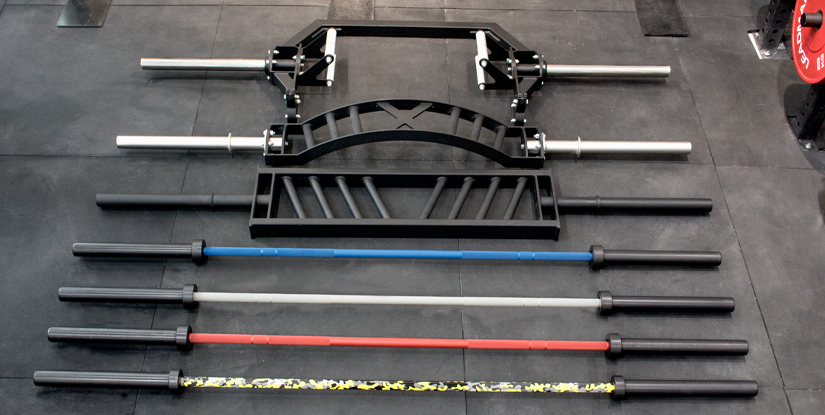Trap bar deadlift vs conventional—it’s a question almost every lifter runs into. Both are deadlifts. But they don’t feel the same. The setup, the muscles, even how your body moves—pretty different.
With the trap bar, you’re standing inside the weight. Feels more upright. Some say it’s easier on the back. The conventional deadlift? Classic bar in front. More hip hinge. More tension on the backside.
So which one should you do? Honestly—it depends. What’s your goal? Bigger legs? Stronger back? Just starting out?
In this article, we’ll keep things simple. You’ll learn what makes each deadlift unique, who they work best for, and how to pick the right one for you.
What Is the Trap Bar Deadlift?
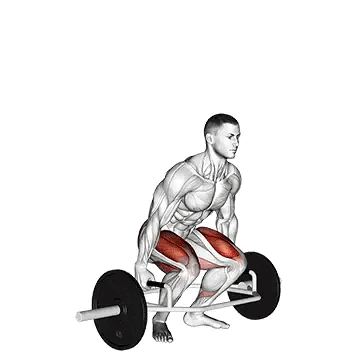
The trap bar deadlift exercise is a type of deadlift where you use a hexagon-shaped bar.
You literally step into the bar—not behind it. Your hands stay by your sides, kind of like carrying heavy bags.
It feels easier, more natural. And yeah, your back usually thanks you for it. Some people say it’s like a squat and a deadlift had a baby. Kinda true.
✅ Muscles it works
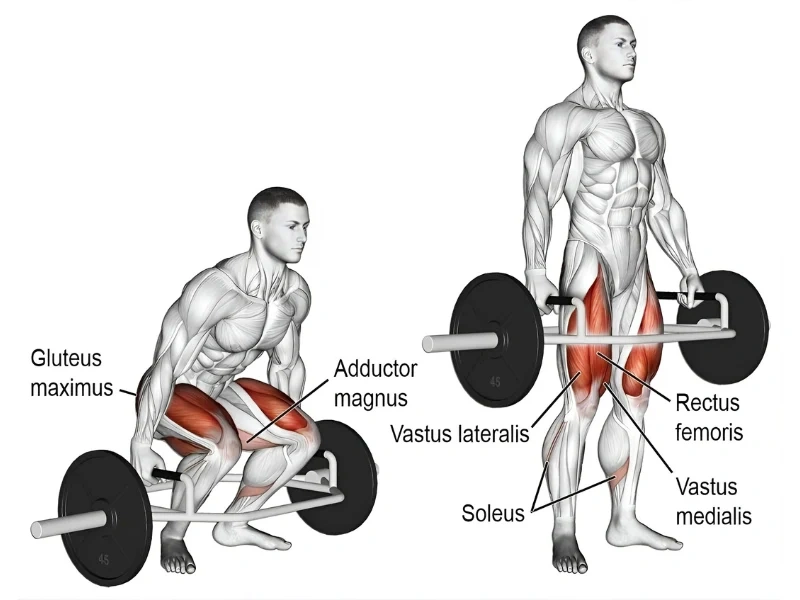
- Quads – your front thighs do more work here than in a regular deadlift.
- Glutes – still a big part of the lift, especially at the top.
- Hamstrings – active, but not stretched as much as with a straight bar.
- Traps and upper back – help you stay upright and hold the weight steady.
- Core – works to keep your body tight and balanced through the lift.
✅ How the movement works
- You stand inside the bar, not behind it.
- Hands grab the handles on each side — your palms face your body.
- Your chest stays up, and your back stays straighter.
- You bend your knees more — it’s like sitting down into the lift.
What Is the Conventional Deadlift?
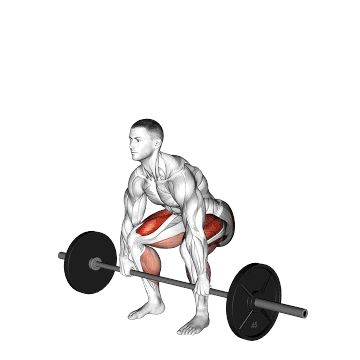
The conventional deadlift is the most classic form of deadlift.
You stand behind a straight barbell and pull it from the ground, with your hands in front of your legs. It’s all about hip drive, full-body tension, and raw strength. This is the one you see in powerlifting.
✅ Muscles it works
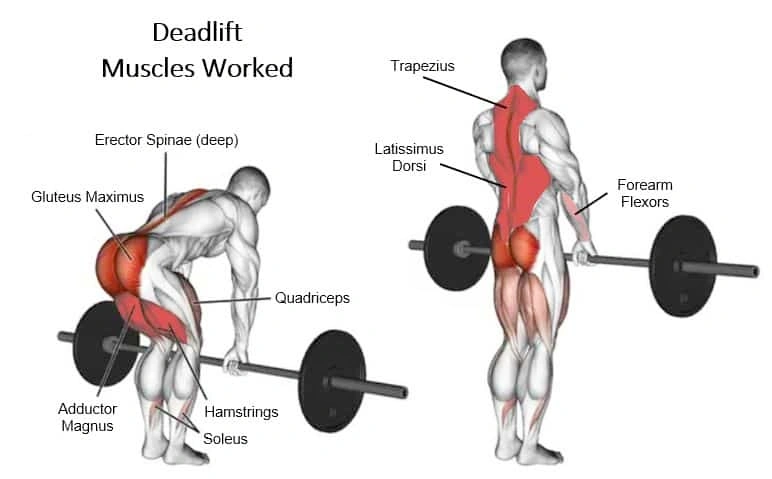
- Hamstrings – these are working hard as you hinge and lift.
- Glutes – big push at the top to lock out the lift.
- Lower back – works more here than in trap bar deadlifts.
- Upper back and traps – help keep your posture and control the bar.
- Core – stays tight the whole time to protect your spine.
- Grip and forearms – the bar wants to roll, so your hands have to work.
✅ How the movement works
- You stand behind the bar, feet about hip-width apart.
- Grip the bar with hands just outside your legs — overhand or mixed grip.
- Hips start higher than in a trap bar deadlift.
- Back stays flat, but you lean forward more.
- You pull through your hips, not your knees. It’s a hinge, not a squat.
Trap Bar Deadlift vs Conventional: Key Differences
So what’s the actual difference? And more importantly—how do you know which one’s right for you?
Let’s break it down real quick.
| Key Point | Trap Bar Deadlift | Conventional Deadlift |
|---|---|---|
| Body Position | More upright. Feels natural. | More forward lean. Needs more control. |
| Main Muscle Focus | Quads, glutes, less stress on lower back. | Hamstrings, glutes, more lower back tension. |
| Lift Path | Straight up from the center. Balanced feel. | Bar stays close to shins. More technical. |
| Ease of Use | Easier for beginners. Less chance of bad form. | Takes more practice. Less forgiving on mistakes. |
| Weight You Can Lift | Usually lift heavier due to better leverage. | Slightly lower loads, but more technical demand. |
| Best For | Safer lifting, leg strength, rehab, general training. | Max strength, powerlifting, full posterior chain. |
✅ In simple terms:
- Just want something simple, safe, and doesn’t feel like it’s trying to break you? Go with trap bar.
- Want to build serious strength and technique? Go with conventional.
- Honestly, either one works. But if you pick the right one for you, it just makes life easier.
Which One Should You Choose?
So—trap bar or conventional? No clear winner. It really comes down to what you want out of your training. Let’s break it down.
🏋️♂️ Beginner
Pick: Trap Bar
Super easy to pick up—even if your form’s a little off, it won’t punish you. The setup feels natural, and it builds confidence fast.
🏋️♂️ Want bigger legs
Pick: Trap Bar
You bend your knees more, which hits your quads harder. Plus, most people can lift more with it—great for progressive overload.
🏋️♂️ Want stronger glutes & hamstrings
Pick: Conventional
This version relies more on hip hinge. It stretches and loads your backside better, especially your hamstrings and glutes.
🏋️♂️Training for powerlifting
Pick: Conventional
This is the one used in meets. You need to practice it if you’re serious about competing or testing max strength.
🏋️♂️ Athletic training / explosive power
Pick: Trap Bar
It allows for a faster pull and a more upright drive—closer to how you jump or sprint. Great for sports training.
🏋️♂️ Lower back issues or injury recovery
Pick: Trap Bar
Less leaning. Less back stress. If something feels off, no panic—it’s way more forgiving than the straight bar.
Bottom line? Go with what makes sense for you. Your goal. Your body. And honestly? No rule says you have to pick just one.
You can actually use both—here’s how.
Can You Use Both?
Yes—you can use both. And to be honest, it’s probably the smartest move.
Trap bar and conventional deadlifts work your body in different ways. One’s not better. They just do different things.
It’s like changing lanes. You avoid overuse, build strength from different angles, and yeah—it makes lifting more fun.
💡 Why bother using both?
- More muscle coverage – Trap bar hits your quads more. Conventional hits your backside more.
- Less wear and tear – Switching it up gives your joints and back a break.
- More ways to train – Use one for strength training, the other for speed or volume.
💡 Easy weekly plan example
| Day | What to train | Which lift | Why |
|---|---|---|---|
| Monday | Heavy strength work | Conventional deadlift | Best for building raw pulling power |
| Wednesday | Power and speed | Trap bar deadlift | Feels fast and explosive |
| Friday | Muscle and volume | Trap bar deadlift (lighter) | Easier on your back, great for legs |
You don’t have to follow this exact setup. Just swap between the two based on how you feel and what you’re working on.
Bottom line? Using both gives you more tools to train smarter—and stay strong longer.
Final Thoughts
So—trap bar deadlift vs conventional deadlift. It’s not about which one is better. It’s about which one works better for you.
Both build strength. Both hit big muscles. They just do it in different ways.
If you’re new, the trap bar is a great place to start. If you’re chasing raw strength or competing, conventional is a must. But honestly? You don’t have to pick sides.
Use both. Mix them in. Listen to your body.
The “best” deadlift? It’s the one that feels good, works for you, and keeps you coming back without hating the process.
Now go lift something heavy.

Hi, I’m Alex Carter, part of the editorial team at Leadman Fitness. We specialize in crafting premium custom racks, cable machines, functional trainers, and strength accessories for home and commercial gyms. With a background in competitive powerlifting and gym design consulting, I’ve spent years testing gear under heavy loads and optimizing layouts for efficiency.
I focus on translating real-world user frustrations—like space limitations, budget constraints, or durability needs—into actionable solutions. By collaborating directly with our engineers and facility owners, I ensure our custom equipment evolves to solve the unspoken challenges lifters face daily. What I share isn’t textbook advice; it’s battle-tested insight from racks I’ve welded, cables I’ve replaced, and gym floors I’ve trained on.
